The Elements of Special Prosecution
June 26th. marked the anniversary of one of the greatest infamies committed in contemporary times by the U.S. Government against its own First People. On that day, in 1975, federal agents entered the Sioux Reservation, purportedly to question a crime suspect. Their invasion dissolved into mayhem and overt violence. Their primary motivation, however, was as it has been since 1870; to coerce or persuade the property owners to sell their land for industrial and natural resource development; primarily in heavy minerals, including Black Hills gold. A gunfight broke out and two of the F.B.I. agents were killed. Three of the inhabitants were later arrested and charged with murder. Two of the defendants were acquitted through a self-defense plea. One was not. He was tried, found guilty, and given two consecutive life sentences. His name was Leonard Peltier.
Attempts to free Leonard Peltier of the charges that occurred under the same circumstances with the same anxiety to defend his own life, have repeatedly failed. His initial arrest and confinement caused a flurry of interest in Native American affairs. “Free Leonard Peltier” posters decorated the homes of political activists, protests lined the streets of major Universities, and a copy of “Bury My Heart at Wounded Knee” lay on the coffee table of every informed household.
What does the book, which is a historical account of the 1870’s US Government’s battle with the Sioux Nation have to do with Leonard Peltier? Quite a bit. In the late 1960’s, frustrated by decades of discrimination and intrusive federal policies, Native American community activists led by George Mitchell, Dennis Banks, and Clyde Bellecourt met with 200 other tribal members to discuss these issues and the means of taking over their own destiny. Together, they created a new entity, a powerful voice speaking out against slum housing, joblessness and racist treatment among the First People. They became the foundation for the American Indian Movement (AIM).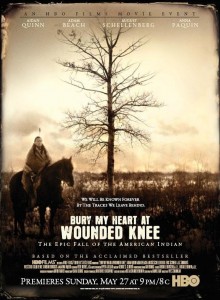
The American Indian Movement opened the K-12 Heart of the Earth Survival School in 1971, and in 1972, mounted the Trail of Broken Treaties march on Washington, D.C., where they took over the Bureau of Indian Affairs (BIA), in protest of its policies, and with demands for their reform.
According to the Minnesota Historical Library, “The revolutionary fervor of AIM’s leaders drew the attention of the FBI and the CIA, who then set out to crush the movement. Their ruthless suppression of AIM during the early 1970s sowed the seeds of the confrontation that followed in February, 1973, when AIM leader Russell Means and his followers took over the small Indian community of Wounded Knee, South Dakota, in protest of its allegedly corrupt government. When FBI agents were dispatched to remove the AIM occupiers, a standoff ensued. Through the resulting siege that lasted for 71 days, two people were killed, twelve wounded, and twelve hundred arrested. Wounded Knee was a seminal event, drawing worldwide attention to the plight of American Indians. AIM leaders were later tried in a Minnesota court and, after a trial that lasted for eight months, were acquitted of wrongdoing.”
Wounded Knee is part of the eight district Pine Ridge Ogala Lakota Reservation. Leonard Peltier traveled to the reservation in 1975 as an AIM member to help try and bring a peaceful end to the violence. He became caught up in the conflict when the two FBI agents entered the reservation in search of a Pine Ridge resident named Jimmy Eagle, who was wanted for questioning in a robbery and assault.
The invasion of federal officers, which lasted well into the late nineteen seventies, continuing after the arrest of Peltier, is referred to by the Lakota tribe as the reign of terror. Fifty-six names are listed on a memorial page honoring the Pine Ridge members who had lost their lives during this modern day battle with US Government sponsored land grabbers. Fifty-six names that did not make the headlines, whose deaths were not investigated to discover the culpable, whose voices were not heard by the American public. The fight Leonard Peltier joined in was the same as the seventy-one day siege at Wounded Knee, the same as the one that silenced forever fifty-six members of his community, the same as the one in which two other men were arrested on charges of murder and later acquitted through a self-defense plea.
According to the Leonard Peltier Defence Committee website, “Key witnesses were banned from testifying about FBI misconduct and testimony about the conditions and atmosphere on the Pine Ridge Reservation at the time of the shoot-out was severely restricted. Important evidence, such as conflicting ballistics reports, was ruled inadmissible. Still, the U.S. Prosecutor failed to produce a single witness who could identify Peltier as the shooter. Instead, the government tied a bullet casing found near the bodies of their agents to the alleged murder weapon, arguing that this gun had been the only one of its kind used during the shootout, and that it had belonged to Peltier.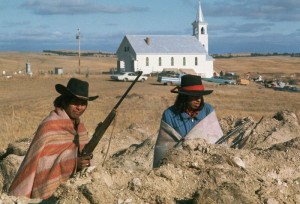
Later, Mr. Peltier’s attorneys uncovered, in the FBI’s own documents, that more than one weapon of the type attributed to Peltier had been present at the scene and the FBI had intentionally concealed a ballistics report that showed the shell casing could not have come from the alleged murder weapon. Other troubling information emerged: the agents undoubtedly followed a red pickup truck onto the land where the shoot-out took place, not the red and white van driven by Peltier; and compelling evidence against several other suspects existed and was concealed.”
The Poet Behind the Bars
Leonard Peltier is behind bars, but his voice has not been silenced. His book, “Prison Writings; My Life is My Sun Dance”, has received International acclaim, attracting even the attention of Britain’s Queen Elizabeth of Britain. Archbishop Desmond Tutu called it: “A deeply moving and very disturbing story of a gross miscarriage of justice and an eloquent cri de coeur of Native Americans for redress and to be regarded as human beings with inalienable rights guaranteed under the United States Constitution. We pray that it does not fall on deaf ears. America owes it to herself.”
His list of achievements has been extraordinary:
- In 1992 he established a scholarship at New York University for Native American students seeking law degrees.
- Instrumental in the establishment and funding of a Washington (state) Native American newspaper by and for Native young people.
- Has been the sponsoring father of two children in Childreach, one in El Salvador, and the other in Guatemala.
- Has worked to have prisoners’ artwork displayed around the country and the world in art galleries in hopes of starting art programs for prisoners and increasing their self-confidence.
- Has sponsored several clothing and toy drives for reservations.
- Distributes to Head Start and halfway houses, as well as women’s centers.
- Every year he has sponsored a Christmas gift drive for the children of Pine Ridge, SD. Organized and emergency food drive for the people of Pohlo, Mexico in response to the Acteal Massacre.
- Serves on the board of the Rosenberg Fund for Children.
- Donates his artwork to several human rights and social welfare organizations in order to help them raise funds. This most recently includes the ACLU, Trail of Hope (a Native American conference dealing with drug and alcohol addiction), World Peace and Prayer Day, the First Nation Student Association, and the Buffalo Trust Fund.
By donating his paintings to the Leonard Peltier Charitable Foundation, he was able to supply computers and educational supplies such as books and encyclopedias to libraries and families on Pine Ridge.
By donating his paintings to the LPCF, he was also able to raise substantial supplies for the people of Pine Ridge after last year’s devastating tornado hit and caused a multitude of damage on the reservation.
He has been widely recognized for his efforts and has won several human rights awards, including the North Star Frederick Douglas Award, Humanist of the Year Award, and the International Human Rights Prize.
America’s Third World Citizens
Understanding Peltier’s passion requires understanding the conditions of the Pine Ridge Reservation. The 11,000-square mile (approximately 2,700,000 acres) Pine Ridge Reservation is the second-largest Native American Reservation within the United States. It is roughly the size of the State of Connecticut. According to the Oglala Sioux tribal statistics, approximately 1,700,000 acres of this land are owned by the Tribe or by tribal members.
The topography of the Pine Ridge Reservation includes the barren Badlands, rolling grassland hills, dryland prairie, and areas dotted with pine trees.
The Pine Ridge Reservation is home to approximately 40,000 persons, 35% of which are under the age of 18. The latest Federal Census shows the median age to be 20.6 years. Approximately half the residents of the Reservation are registered tribal members of the Oglala Lakota Sioux Nation.
The median income of the Pine Ridge Reservation is $2,600 to $3,500 a year. The unemployment rate averages around 83-85% and can be higher in the winter when travel is difficult or even impossible. The average life expectancy for women is fifty-two years, for men, it’s forty-eight. The rate of diabetes and tuberculosis are eight hundred times the U.S. National average. The rate of cervical cancer is five hundred times the U.S. National average.
It is reported that at least 60% of the homes on the Pine Ridge Reservation are infested with Black Mold, Stachybotrys. This infestation causes an often-fatal condition with infants, children, elderly, those with damaged immune systems, and those with lung and pulmonary conditions at the highest risk. Exposure to this mold can cause hemorrhaging of the lungs and brain as well as cancer.
A Federal Commodity Food Program is active but supplies mostly inappropriate foods (high in carbohydrate and/or sugar) for the largely diabetic population of the Reservation. A small non-profit Food Co-op is in operation on the Reservation but is available only for those with funds to participate.
In most of the treaties between the U.S. Government and Indian Nations, the U.S. government agreed to provide adequate medical care for Indians in return for vast quantities of land. The Indian Health Services (IHS) was set up to administer the health care for Indians under these treaties and receives an appropriation each year to fund Indian health care. Unfortunately, the appropriation is very small compared to the need and there is little hope for increased funding from Congress. The IHS is understaffed and ill-equipped and can’t possibly address the needs of Indian communities. Nowhere is this more apparent than on the Pine Ridge Reservation.
Living conditions are crowded. As many as seventeen people live in two and three bedroom homes, while homes built to contain six to eight people will have up to thirty inhabitants. Many of the homes lack adequate furniture, use their cooking stove for heat, and some have only dirt floors. Thirty-nine percent of the homes are without electricity. Sixty percent of the reservation families have no land-line telephones. Computers and Internet connections are rare.
Efforts to improve their living conditions by investing in businesses have been met with frustration. Currently there are no movie theaters, only one grocery store, one motel and a few scatter bed and breakfast arrangements. Several of the banks and lending institutions nearest to the Reservation have been targeted for investigation of fraudulent or predatory lending practices, with the citizens of the Pine Ridge Reservation as their victims.
Many wells and much of the water and land on the Reservation is contaminated with pesticides and other poisons from farming, mining, open dumps, and commercial and governmental mining operations outside the Reservation. A further source of contamination is buried ordnance and hazardous materials from closed U.S. military bombing ranges on the Reservation.
Scientific studies show that the High Plains/Oglala Aquifer which begins underneath the Pine Ridge Reservation is predicted to run dry in less than 30 years due to commercial interest use and dryland farming in numerous states south of the Reservation. This critical North American underground water resource is not renewable at anything near the present consumption rate. The recent years of drought have simply accelerated the problem.
Scientific studies show that much of the High Plains/Oglala Aquifer has been contaminated with farming pesticides and commercial, factory, mining, and industrial contaminants in the States of South Dakota, Wyoming, Nebraska, Kansas, Colorado, New Mexico, Oklahoma, and Texas.
The conditions of the Sioux reservation are not unique. To varying degrees, these conditions exist on nearly all the U.S. reservations. It is to this plight that Peltier and others like himself would address our attention. It’s not an appeal to assimilate into a society that rejects their cultural heritage, but an appeal to accept them complete with their culture. It is not an appeal for hand-outs but for fair business practices. It’s not an appeal based on abandoning their old ways, but one of incorporating modern technology and education for a new nation. For over a hundred years, Pine Ridge has defended itself against self-interested groups that sought to establish themselves from within. Now they are encroached upon by these same interest groups from without. They have been harmed. They have lost their means of livelihood, their health, their clean water, and yet they keep gathering. The community grows as their urban cousins leave the cities to join them. They gather because they must. Their desperation is a call to all who have been swept aside as unimportant, unsubstantial, inconvenient. They will be heard.
Silence, they say, is the voice of complicity.
But silence is impossible.
Silence screams.
Silence is a message,
just as doing nothing is an act.
-Leonard Peltier-
Leonard Peltier was born September 12, 1944. In 1977, at the age of thirty-three, he was sentenced to prison. In 2009, he was granted a full hearing before the United States Parole Commission. His parole request was denied. Peltier’s next scheduled hearing is set for July, 2024. Should he live that long, he will be eighty years old. He has already spent more than half his life in prison for a crime that began as a crime against the Native American people and that amounts to selective prosecution, suppression and the concealment of vital evidence. In the time he has spent behind bars, he has contributed more to the good of his country than most of our Senators, Representatives, Congressmen, diplomats, business owners and billionaires. He is a humanitarian, yet the humanitarian compassion of the US public has not freed him. He is an author, a poet, a craftsman, a spokesperson for human rights. History will not remember him as a murderer, but as a man who sought equality. The wounded hearts, suffering under the tyranny of corruption, will embrace him.
Whatever debts he owed society, Peltier has more than adequately paid them. Society owes him a debt in return. It owes him the safe guarding of the rights of America’s First People to thrive. It owes him recognition of his worth, which cannot be measured in terms of war against the Government of the U.S., or in personal wealth, but in his deeds. It owes him his freedom.
If you would like to read the messages of Leonard Peltier, click here.
Resources:
http://www.mnhs.org/library/tips/history_topics/93aim.html
http://www.leonardpeltier.net/theman.htm
http://www.nativevillage.org/Messages%20from%20the%20People/the%20arrogance%20of%20ignorance.htm
http://www.leonardpeltier.net/

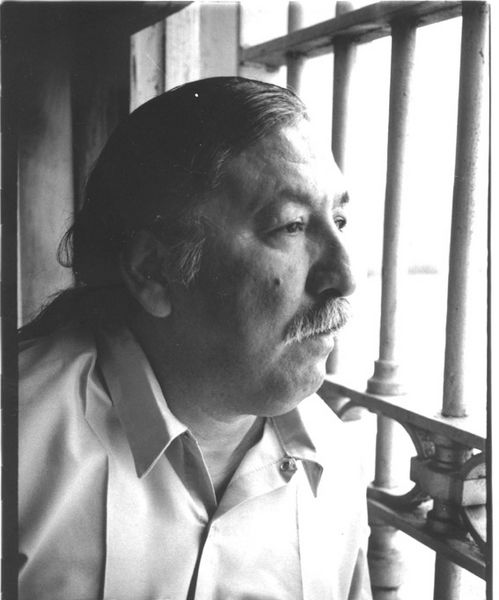
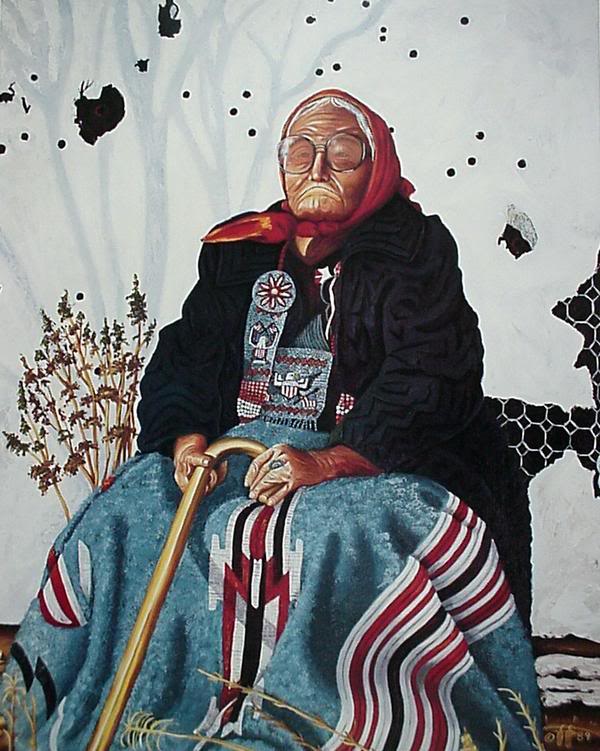
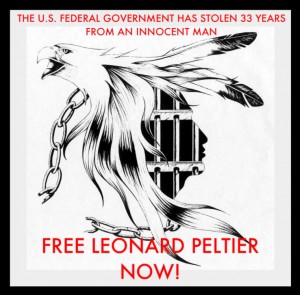
What a great story! Always standing up for injustice, that’s our Karlsie. It’s excellent that stories like this are getting mainstream publicity. It makes others accountable. And whether or not the government reverses its corrupt decisions, at least people know the truth.
Thanks Karla, after the last hearing so much of the push to support Peltier seemed to drop away. My old car which has been handed down still bears its “Free Leonard Peltier” sticker on it. Hopefully the new generational owner will get questions.
I feel that people know the truth and for whatever reason are not mustering up what it takes to do anything. Not surprising.
It is the accountability that concerns me. The US Government has not felt itself accountable for the conditions that created the poverty on the reservations. The attitude is, “if you’d just sell out (your property, your natural resources) we can make all this better. In the meantime, you are boycotted of your rights as a human being.”
So much arrogance… Peltier has not been judged by a jury of his peers. If he had, they would have been humanitarians, people of sacrifice and conviction. He was judged by a jury whose greatest contribution is their degree of consumerism. He was judged by a governing body whose greatest contribution to the First People was a horse. A governing body that hides behind the law it created on its own for the purpose of stealing other people’s resources.
While Peltier remains in prison, the reservations remain a prison, the outcasts that would not comply so must be punished. While the reservations remain a prison, so then are we, the common people who toil and labor for a living, who dream of homes our entire lives will not pay for, who wish for cats and dogs or swing sets in our yards, who cry out to be recognized as individuals; we are all in prison.
After so many years, it’s no longer a question even of whether or not Peltier is guilty. He has paid his debts to society. How much of society, when placed in judgment, can say it paid theirs?
[…] By Karla Fetrow at Subversify.com […]
On June 27, Leonard Peltier was removed from the general population at USP-Lewisburg and thrown in the hole. Little else is known at this time. Due to his age and health status, please join us in demanding his immediate return to general population.
Thomas Kane, Acting Director
Federal Bureau of Prisons
E-Mail: info@bop.gov
Web Site: bop.gov [bop.gov]
Phone: (202) 307-3198
Fax: (202) 514-6620
Address: 320 1st Street, NW
Washington, DC 20534
Nancy, thank you for the update and the contact information. I hope our readers will all do their part to petition for fair and ethical treatment, and the release of Leonard Peltier from prison. US justice is a mockery and nothing illustrates it more clearly than the case of Leonard Peltier.
Pour un gouvernement qui prône dans le monde entier paix et justice, Je trouve que côté justice, comme nous le disont en France, ils devraient déjà balayer devant leur porte avant de le faire chez les autres. Léonard a été un bouc émissaire: Le gouvernement voulaient un coupable et ont accusé Léonard pour le mettre hors circuit parce qu’il les gênait.
Bref, le coupable idéal.
[…] families and libraries at Pine Ridge. Another of his paintings, “Grandma Jumping Bull,” can be seen here (scroll down a […]
Some really nice and utilitarian info on this site, too I believe the pattern contains great features.
Peltier is no more a political prisoner than Charles Manson. Or is he? President Obama did not merely ignore inmate Peltier’s petition for clemency; he formerly rejected it. Why? Documented quotes tell the tale, beginning with Leonard’s big whopper:
“This story is true.”
Leonard Peltier, assuring his supporters that a mysterious Mr. X shot the FBI agents, as depicted in Robert Redford’s discredited documentary, Incident at Oglala.
“Peter, you put my life in jeopardy and you put the lives my family in jeopardy by putting that bullshit in your books. Why didn’t you call me and ask me if it was true?”
Dean Butler, chastising Peter Matthiessen for promoting Peltier’s sworn alibi, Mr. X, in his book, In the Spirit of Crazy Horse. Peltier’s lawyer, Mike Kuzma, publicly admitted that the X story was “concocted” as are all of Peltier’s alibis. Note: The stand-in who played “Mr. X” in Peltier’s video (as seen on 60 Minutes) has been exposed as AIM member and “Mt Rushmore bomber,” David Hill.
“I seen Joe when he pulled it out of the trunk and I looked at him when he put it on, and he gave me a smile.”
Leonard Peltier, standing over the bodies of Jack Coler and Ronald Williams moments after their heads were blown off, commenting on Joe Stuntz wearing Jack Coler’s green FBI jacket taken from his car trunk, as quoted from, In the Spirit of Crazy Horse.
“I didn’t think nothing about it at the time: all I could think of was, We got to get out of here!”
Leonard Peltier, reacting to Joe Stuntz wearing Jack Coler’s jacket, quote from In the Spirit of Crazy Horse. Peltier could hear the chatter over the FBI car radio from other agents who were racing to the scene and attempting to re-establish contact with Agent Williams in response to his calls for help. The Eighth Circuit court of Appeals established that Peltier initially opened fire on the agents because he mistakenly thought they were there to arrest him. Peltier also feared that the agents would discover his armed encampment where numerous weapons, boxes of ammo, bomb-making materials, and several hand grenades lay hidden in the trees.
“I heard the bullet go whizzing by my head.”
FBI Agent Dean Hughes, describing Joe Stuntz shooting at him after being repeatedly warned to stop firing at responding law enforcement officers. A BIA officer returned fire and killed Stuntz, an ex-convict who had volunteered to stay behind and help Peltier escape from the murder scene, as quoted in American Indian Mafia.
Mark Potter: “Did you fire at those agents, Coler and Williams?
Leonard Peltier: “I shot in their direction, yes.”
CNN interview, Oct 1999. Later in the interview, Peltier admits for the first time on camera that he left his firing position near a large tree and stood over the two dead agents moments after they were both shot in the head at point-blank range.
“…I can’t tell the system I was shooting at their police officers that were trying to arrest me. They’ll hold that against me. I’ve got to be careful about that stuff.”
Leonard Peltier, 1995 interview with Native journalist Richard LaCourse, admitting that he mistakenly believed the FBI agents were there to arrest him. Peltier was a wanted fugitive at the time for the attempted murder of a police officer in Wisconsin. Agents Coler and Williams were looking for someone else when Peltier opened fire on their FBI cars, apparently recognizing the vehicles from the day before when the agents had visited the same compound in the same cars.
“When all is said and done, however, a few simple but very important facts remain. The casing introduced into evidence in fact had been extracted from the Wichita AR-15. This point was not disputed.”
Eighth Circuit Court of Appeals, Feb 1986, finding of fact that a shell casing found at the murder scene was ejected from the AR-15 assault rifle carried by Leonard Peltier. Over a hundred shell casings, all matched to Peltier’s weapon, were found in the area where he was seen shooting and over a hundred bullet holes were found in the FBI cars.
“The record as a whole leaves no doubt that the jury accepted the government’s theory that Peltier had personally killed the two agents, after they were seriously wounded, by shooting them at point blank range with an AR-15 rifle ….The critical evidence in support of this theory was a casing from a .223 caliber Remington cartridge recovered from the trunk of [the car of one of the murdered agents] …The district court, agreeing with the government’s theory … sentenced Peltier to two consecutive life sentences.”
United States v. Peltier, 800 F.2d 772, 772-73 (8th Cir. 1986), cert. denied, 484 U.S. 822, 108 S. Ct. 84, 98 L. Ed. 2d 46 (1987).
The two witnesses testified outside the presence of the jury that after their testimony at trial, they had been threatened by Peltier himself that if they did not return to court and testify that their earlier testimony had been induced by F.B.I. threats, their lives would be in danger.”
United States v. Peltier, 585 F. 2d 314, U.S. App. Decision September 14, 1978.
“The mother—er was begging for his life but I shot him anyway.”
Sworn testimony attributed to Leonard Peltier, boasting in the Marlon Brando motor home about shooting Ronald Williams, as heard by Dennis Banks, Ka-Mook Banks, Bernie Lafferty, and (soon-to-be-murdered) Anna Mae Pictou Aquash. According to the autopsy report, Agent Williams died with his right hand held up in front of his face; there were powder burns on his fingers.
“”This story that the government admitted they don’t know who shot the agents comes from an out-of-context comment attributed to prosecutor Lynn Crooks. Let me tell you something. I know Lynn Crooks, and there is no one on the planet more convinced of Peltier’s guilt than Lynn Crooks.”
John M. Trimbach, American Indian Mafia
“… the greater probability is that you yourself fired the fatal shots… It would be unjust to treat the slaying of these F.B.I. agents, while they lay wounded and helpless, as if your actions had been part of a gun battle. Neither the state of relations between Native American militants and law enforcement at the Pine Ridge Indian Reservation prior to June 26, 1975, nor the exchanges of gunfire between individuals at the Jumping Bull Compound and the law enforcement agents who arrived there during the hours after Agents Coler and Williams were murdered, explains or mitigates the crimes you committed…Your release on parole would promote disrespect for the law in contravention of 18 U.S.C….”
Leonard Peltier’s 1999 Parole Board, commenting on his aiding and abetting conviction.
“The circumstantial evidence presented at the extradition hearing, taken alone [without the Poor Bear affidavits], constituted sufficient evidence to justify Mr. Peltier’s committal on the two murder charges.”
Anne Mcellen, Canadian Minister of Justice, in a letter to Attorney General Janet Reno, October 12, 1999, affirming that Peltier was lawfully extradited to the US to stand trial for murder.
“Anna Mae Aquash was executed by a single gunshot to the back of her head on orders from the American Indian Movement because they believed her to be an informant for the FBI…”
Supreme Court of British Columbia, Vancouver, Canada, June 26, 2007.
“There is no doubt that in June 1975 Leonard Peltier put a loaded gun in my mother’s mouth during one of her interrogations and that six months later, other members and leaders of the American Indian Movement carried out my mother’s torture, rape and murder. Leonard knows a lot about the people involved but even today, after all these years, he refuses to cooperate in the on-going murder investigation.”
Denise Maloney, daughter of AIM murder victim Anna Mae Pictou Aquash (Mi’kmaq).
“But in the end, while crossing back and forth over the issue of ‘without doubt,’ and crossing back again to wonder, it simply took a delegation of people who were tired of all the deceptions, lies and dangers to step forward and tell me the truth. ‘Peltier was responsible for the close range execution of the agents…’ and that was the end of that.“
Native journalist Paul DeMain, April 2, 2007, writing about “people who have agonized for years, grandfathers and grandmothers, AIM activists, Pipe carriers and others who have carried a heavy unhealthy burden within them that has taken its toll.”
“For me it’s something very heroic that he’s done. He’s putting himself at risk, seriously at risk. I will say this: that this brother is a very strong brother. He is not a cold-blooded murderer. He is not a bad person, he’s very kind, generous and sincere.”
Leonard Peltier, 1991 Darrin Wood interview, describing the man who executed Ronald Williams and Jack Coler.
“I never thought my commitment would mean sacrificing like this, but I was willing to do so nonetheless. And really, if necessary, I’d do it all over again, because it was the right thing to do.”
Message from the “Bernie Madoff of political prisoners” to his supporters, 2/6/2010.
Parole may be granted when the offender’s “…release would not depreciate the seriousness of the offense.”
DOJ policy statement on parole.